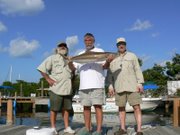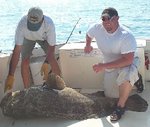Dolphin Bite Progress
As usual the offshore bite changes with water temperature. Two weeks ago we were hunting for water warmer than 77 degrees now we are looking for cooler than 80 degrees, which would be coller than the inshore and reef water temperature.
With all the water warm there are small peanuts everywhere which makes finding the big fish a bit harder. So you end up guessing on burning fuel heading way south or burning time staying close and looking for magic floaters. This is where switching over to rigged ballyhoo can produce big fish or lots of cussing as the peanuts eat your rigged 'hoo. I am still a fan of using pitched baits live or rigged for the big fish and using the darts to pick up whatever then be real slow getting the whatever to the boat. More than once I have traded up from a peanut on a dart to a slammer. It is not something I count on but it does happen.
More often you will spot a bigger fish checking out the peanut which you tend pitch to or just pitch a bait past the peanuts if you don't have a tower and hope. Staying close is often a good thing, especially when there is a color change caused by the tide. That is a great reason to like the old Seven Mile Bridge. With more current flow you tend to get good color changes if there is a little wind. That color change can be way down near Bahia Honda, but if the Sargasso is fresh and bunched up nice there is a good chance you can find your bucket list Dolphin. That does take patience though which is not a common commodity anymore.
This time of year bigger fish can be 10 pounds to 70 pounds with a lot more on the smaller end. Most of the really big fish I have seen in June and July where trade ups, whether the captain knew it or not, in under 400 foot of water. There are of course big fish deep, but most folks tend to stay closer so they can shift over to mutton or grouper fall back plans during the dolphin hunt or just blow off trolling and hit the reef for flag yellow tail or fat spawn mangroves. It is all good to me, but I do get a lot of bucket list fisherman wanting their trophy. That means sometimes I am a hero and sometimes a goat. Such is life.
There are some "secrets" that work from time to time if you find the right floater or patch of weeds. In addition to the usual trick of letting your baits sink deep, you can add a deep diving lure to your spread or if you have enough energy use a butterfly jig around the patches for the deeper running fish. Currently, the butterfly jig thing is getting talked up a bit more than normal but a grunt or pinfish works about a well since they tend to swim down. Live ballyhoo or mullet can be fun and productive as both create a good deal of commotion which tends to attract larger fish, including sailfish and the occasional marlin.
Because of the sinking action, some boats swear by combo rigged ballyhoo on the shotgun or riggers which will tend to sink behind the peanuts attacking the flat lines when you drop to boat to neutral. This is like an automatic pitch bait set up. Heavier lures in general sink better so you can go with that or plan on deep with the deep divers, butterfly jigs or the amazing Tomtate grunt.
There are also a lot of smaller blackfin tuna moving in closer which means there are bigger tuna underneath most of the time. Pulling a 30 plus pounder from under a school of runts is another bonus of thinking deeper. Doesn't work all the time but is worth a shot.
Also keeps you eyes open for tripletail. The last trip on the Lady Catherine we ended up with a mixed bag of Skipjacks, Dolphin, tripletail and some larger than usual almaco jacks which the customers wanted to try. No pictures, mainly because it was just a tad sporty that day.
Marathon in the Florida Keys should be your next fishing vacation destination. Join us for charter fishing, fishing guide trips or our fishing 101 so you can fish on your own with better success.
Tight lines,
Capt. Dallas



No comments:
Post a Comment